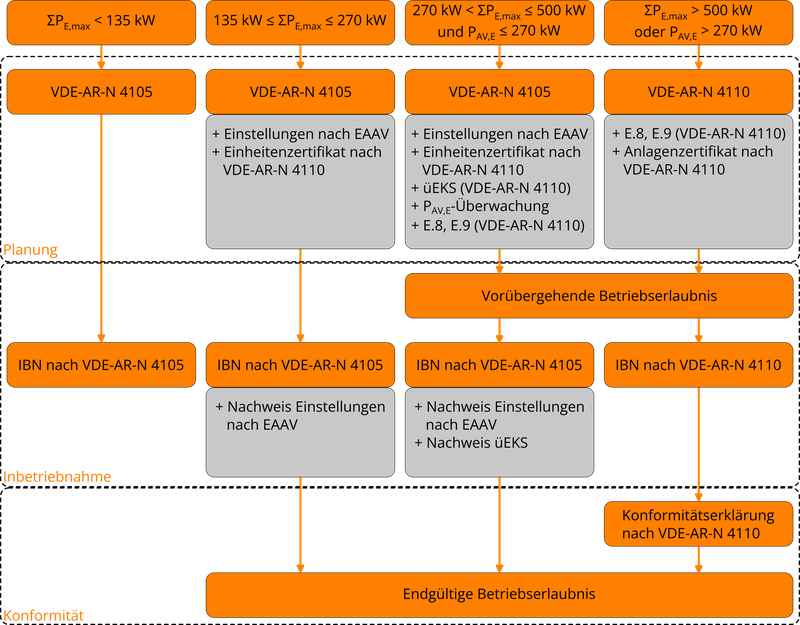Impact of Solar Package I on the grid connection of generation plants
Introduction
The 'Solar Package I', announced in 2023 and providing various changes to the grid connection verification system for generation plants, came into force on 16 May 2024 with the publication of legislative amendments in the Federal Law Gazette. This article provides information on the impact on the verification requirements for new EZA under VDE-AR-N 4110, particularly the obligation to submit plant certificates. It is based on the current version of the Electrical Properties Verification Ordinance (NELEV), the associated VDE/FNN notice, and the Energy Plant Requirements Ordinance (EAAV).
Existing specifications
Prior to the amendments made on 16 May 2024, the legal obligation to submit plant certificates was solely regulated in §2 of NELEV, paragraphs (2), (2a) and (2b). These paragraphs generally stipulate the obligation to issue plant certificates for a cumulative maximum effective power of 135 kW or more. In case of doubt, the VDE/FNN decision-making aid should be consulted. Additionally, §2(2b) of NELEV specifies a minimum scope for systems with a maximum effective power of up to 950 kW, allowing the issuance of system certificates B "subject to conditions" (limited until 31 December 2025). The aforementioned paragraphs remain unchanged. Additionally, VDE-AR-N 4110 distinguishes between plant certificates A (for power plants with a maximum active power greater than 950 kW), plant certificates B (for power plants with a maximum active power of up to 950 kW), and plant certificates C (for an individual verification procedure), which have varying degrees of verification. To determine the scope of verification to be applied, the 'maximum active power' is calculated by adding the PE_(max) values of the installed generation units (EZE) at the common grid connection point (NAP).
Changes effective May 16, 2024
With the amendments made by the legislature on May 16, 2024—in particular the addition of the new paragraph (4) in NELEV §2—the areas of service in which plant certificates are mandatory for grid access are restricted. The exemption from the obligation to submit plant certificates then applies to type B EZA that
- provide a maximum feed-in capacity of 270 kW at the NAP,
- have a cumulative installed capacity of up to 270 kW at the NAP,
- have valid unit and component certificates.
Additionally, this exception applies to EZA Type B with a cumulative installed capacity of between 270 kW and 500 kW at the same NAP, provided that it is connected to a medium or higher voltage and that additional higher-level decoupling protection (üEKS) is present.
Reference to technical specifications in the grid connection procedure
The service areas described above cannot initially be readily assigned to the standard technical performance specifications in the relevant grid connection procedure documents (e.g. unit certificates, forms E.8 and E.9). The VDE/FNN note mentioned at the beginning provides a solution to this issue. Section 4.1 of the VDE/FNN note first defines the power terms in more detail.
- When calculating the 'cumulative installed capacity' as defined in NELEV §2(4) sentence 1, the total capacity of all EZE systems must be added together. No distinction is made between old, existing or new EZE, or between type 1 and type 2 EZE. Therefore, the sum of the maximum active feed-in power of all EZE (ΣPE,max), where PE,max usually corresponds to the 10-minute average value (P600), is the decisive factor. For EZE for which no information on PE_(max) is available, the rated active power Pr_E must be used instead.
- In the case of permanent password-protected power reduction in the EZE, the reduced power PE,max,red can also be used for these.
Note: For Type 2 EZE, i.e., PV inverters, the AC power ratings must always be used. DC power ratings (“kWp”) are generally irrelevant for grid connection verification purposes.
Further details on the information provided in NELEV §2 (4) are given in the VDE/FNN note in section 4.2:
- In general, a system certificate is not required if the cumulative installed capacity (ΣPE,max) is less than 270 kW and the agreed connected active power (PAV,E) is equal to or less than 270 kW. This information can be found in grid operator questionnaire E.9.
- The same applies to configurations with a maximum power of 500 kW and a maximum active power of 270 kW; in this case, an additional ÜEKS is required.
For all other plant configurations, plant certificates are still required in accordance with the provisions of NELEV §2, paragraphs (2), (2a), and (2b).
Impact on the scope of evidence
Different verification requirements apply for the grid connection depending on the connection situation or combination of ΣPE,max and PAV,E. These range from simple verification with unit certificates and commissioning in accordance with VDE-AR-N 4105 for PV systems with ΣPE,max < 135 kW, to a system certificate and declaration of conformity in accordance with VDE-AR-N 4110 for PV systems with ΣPE,max > 500 kW or PAV,E > 270 kW. Special features of the technical connection conditions (TAB) of the responsible grid operator may also have to be taken into account in individual cases.
In addition to the aforementioned regulations and directives, the legislator has enacted the EAAV, which will also take effect on 16 May 2024. This defines certain protective settings for EZA, which fall under the provisions of NELEV §2(4), as explained above.
The following graphic provides an overview of the scope of the documentation for the relevant system and service configurations.

Summary
This article provides clear and detailed information on the impact of the new regulations in 'Solar Package 1' on the documentation requirements for new EZA within the meaning of VDE-AR-N 4110 (obligation to submit plant certificates), as reflected in the current version of the Electrical Properties Verification Ordinance (NELEV), the associated VDE/FNN notice and the Energy Systems Requirements Ordinance (EAAV). This information is intended to provide electrical planners and other stakeholders with a concise introduction to this complex topic.
